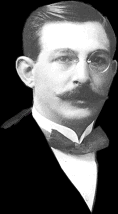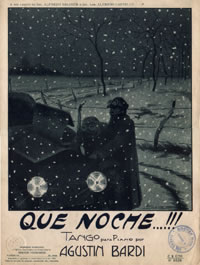By
Qué noche - “¡Qué noche!”, a tango for a very cold weather.

n June 22, 1918 an unprecedented event took place, snow covered the town and its surroundings.
 That day the pianist Agustín Bardi, El Chino, and his friends Francisco Castello and Pedro Fiorito had gone to the horse racing-track of La Plata. After the race, the trio stayed late dining at a barbecue place and went back home on the same Ford car —owned by Fiorito— they had used to go to the track.
That day the pianist Agustín Bardi, El Chino, and his friends Francisco Castello and Pedro Fiorito had gone to the horse racing-track of La Plata. After the race, the trio stayed late dining at a barbecue place and went back home on the same Ford car —owned by Fiorito— they had used to go to the track.
Fortunately, or unfortunately, to speak with more precision, the car broke down near Parque Pereyra Iraola. To find a mechanical workshop at those lonesome places was an impossible dream. And as if this were not enough, at that moment or maybe a little before, an unexpected snowfall!
To watch a snowfall in Buenos Aires is something like having been a witness in the discovery of America by Christopher Columbus. So those travelers might have been partly amazed because of the unprecedented vision and, at the same time, bothered by the cold temperature and the car’s engine that did not evidence any sign of starting again.
Bardi may have experienced some of those two sensations or perhaps none, since he was completely absent-minded, humming the notes of a tango that he had just invented. Inspiration may come at any time and, sometimes, not at the most suitable time to create a masterpiece. But so things are used to be.
 The second part of the story took place when the drawback in some way was solved –we don’t know how, but it was. Bardi met, soon later, his fellow friend Eduardo Arolas, at the café T.V.O. in the neighborhood of Barracas. There he told Arolas, aka the Tiger of Bandoneon, what happened during the snowfall on their way back to the Capital, without omitting to tell him about the new tango that he had created and for which he still had not found a title. Without the least hesitation, Arolas found it and it turned out extremely suitable: «Call it "¡Qué noche!", Chino.»
The second part of the story took place when the drawback in some way was solved –we don’t know how, but it was. Bardi met, soon later, his fellow friend Eduardo Arolas, at the café T.V.O. in the neighborhood of Barracas. There he told Arolas, aka the Tiger of Bandoneon, what happened during the snowfall on their way back to the Capital, without omitting to tell him about the new tango that he had created and for which he still had not found a title. Without the least hesitation, Arolas found it and it turned out extremely suitable: «Call it "¡Qué noche!", Chino.»
The story was told in different ways not always faithful to reality, as for example on the movie "Derecho viejo" of 1951. I got this information in a conversation with Enrique Puccia and doctor Carlos Muttoni.
Published in the Sunday magazine of the Crónica daily paper.
Some recordings of the tango "Qué noche"
Orquesta Roberto Firpo (1918)
Orquesta Típica Select (31/08/20)
Orquesta Julio De Caro (09/12/26)
Mario Pardo (guitar solo) (1928)
Orquesta Julio De Caro (1930)
Orquesta Juan D'Arienzo (05/03/37)
Orquesta Osmar Maderna (29/09/49)
Orquesta Juan Polito (1952/53)
Orquesta Los Astros Del Tango (1958)
Orquesta Osvaldo Fresedo (02/05/63)
Roberto Grela - Edmundo Zaldívar (guitar duet) (1964)
Orquesta Ricardo Tanturi (1966)
Orquesta Juan D'Arienzo (27/07/67)
Orquesta Osvaldo Pugliese (1968)
Cuarteto Juan Cambareri (1974)
Vanguatrío (1976)
Trío Beba Pugliese (1979)
Cuarteto Cedrón (1990)
Orquesta Alberto Di Paulo (1997)
Trío Luis Di Matteo (1997)
Cuarteto Ernesto Baffa
Orquesta Baffa-Berlingieri